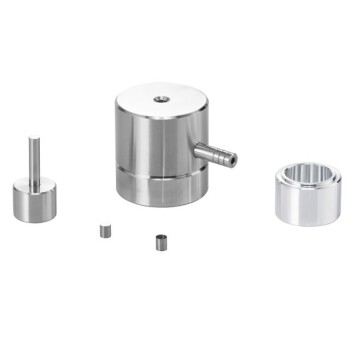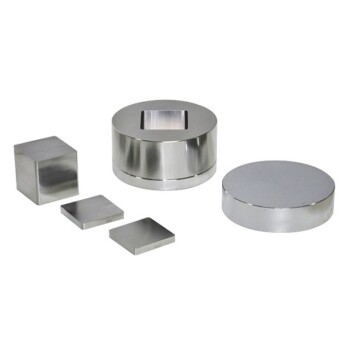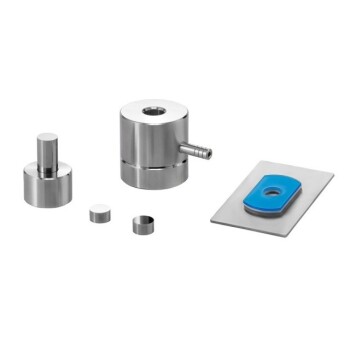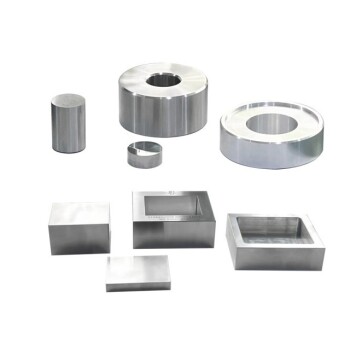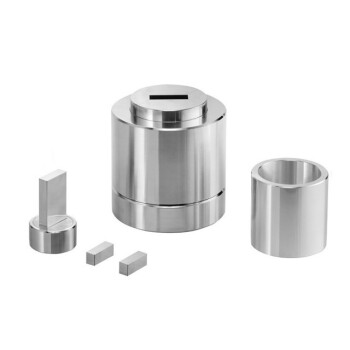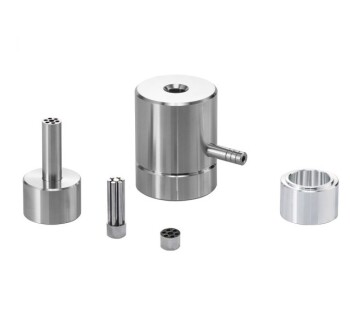At its core, a laboratory press transforms inconsistent raw materials into standardized, high-quality samples for analysis. Its primary role in spectroscopy is to apply controlled pressure, and sometimes heat, to create uniform pellets or thin films from powdered or polymer materials. This preparation is not merely a convenience; it is a fundamental requirement for achieving accurate, repeatable, and meaningful spectroscopic data.
The central purpose of a laboratory press in spectroscopy is to eliminate sample-related variables. By creating a sample with uniform density, thickness, and surface finish, the press ensures that the resulting spectrum reflects the material's true chemical properties, not the physical inconsistencies of an unprepared sample.
The Core Problem: Why Raw Samples Fail in Spectroscopy
Analyzing a loose powder or an uneven material directly with techniques like FTIR or XRF introduces significant errors. The goal of sample preparation is to remove these sources of error before the measurement even begins.
The Issue of Light and Particle Scattering
When an infrared beam (FTIR) or X-ray beam (XRF) hits a loose powder, the light scatters off the irregular surfaces of the particles. This scattering creates significant background noise and dramatically weakens the analytical signal that reaches the detector.
The result is a poor signal-to-noise ratio, making it difficult or impossible to identify chemical components accurately.
The Challenge of Sample Inconsistency
Raw powders have inconsistent density. Some parts are packed tighter than others, meaning the amount of sample the beam interacts with varies across its path.
This lack of homogeneity leads to non-reproducible results. Measuring the same powder twice can yield two different spectra, making the data unreliable for quantitative analysis or precise identification.
How a Laboratory Press Creates Analytical-Grade Samples
A laboratory press directly solves the problems of scattering and inconsistency by physically re-forming the material into an ideal shape and density for analysis.
Creating KBr Pellets for FTIR Spectroscopy
For Fourier Transform Infrared (FTIR) analysis, the most common method is creating a potassium bromide (KBr) pellet. The solid sample is ground and intimately mixed with dry KBr powder.
The press then applies immense pressure to this mixture inside a die, fusing the KBr into a solid, glass-like disc that is transparent to infrared light. The sample is trapped evenly within this KBr matrix, allowing the IR beam to pass through with minimal scattering for a clean, high-quality spectrum.
Preparing Dense Pellets for XRF Spectroscopy
X-ray Fluorescence (XRF) is a surface analysis technique used to determine elemental composition. A press is used to compact a powdered sample into a dense, solid briquette or pellet.
This creates a perfectly flat and homogenous surface. When the X-ray beam hits this uniform surface, it ensures consistent irradiation and fluorescence, drastically improving the accuracy and sensitivity of the elemental analysis.
Producing Thin Films for Transmission Analysis
For polymers and other malleable materials, a heated lab press is often used. The material is placed between two plates, heated to its softening point, and pressed into a thin, uniform film.
This process is essential for transmission spectroscopy, where the IR beam must pass through the sample. The uniform thickness ensures that the measurement (absorbance) is consistent and directly related to the material's chemical structure.
Understanding the Key Parameters
Simply using a press is not enough; the quality of the result depends on precise control over the process. These are the critical variables you must manage.
The Importance of Applied Pressure
The amount of force is critical. Insufficient pressure will result in a fragile pellet that still contains air gaps, leading to scattering. Excessive pressure can sometimes fracture the die or even induce chemical or phase changes in sensitive materials.
The Role of Temperature in Heated Presses
When working with polymers, temperature control is paramount. The goal is to soften the material enough to form a film without causing thermal degradation, which would alter its chemical makeup and produce a misleading spectrum.
The Risk of Contamination
Because spectroscopy is highly sensitive, any contamination can appear in the final spectrum. The press dies must be meticulously cleaned between samples to prevent cross-contamination. Likewise, the KBr used for FTIR pellets must be of spectroscopic grade and kept perfectly dry, as water has a very strong IR signal.
Making the Right Choice for Your Analysis
Your spectroscopic goal dictates your sample preparation strategy. A lab press is a versatile tool, but it must be applied correctly to achieve valid results.
- If your primary focus is FTIR chemical identification: Your goal is to create a transparent KBr pellet by thoroughly mixing your sample with KBr powder and pressing it into a clear disc.
- If your primary focus is quantitative XRF elemental analysis: Your goal is to use the press to form a dense, homogenous pellet with a perfectly flat surface to ensure reproducible measurements.
- If your primary focus is polymer analysis via transmission IR: Your goal is to use a heated press to create a thin film of uniform thickness without thermally damaging the material.
Ultimately, mastering the use of a laboratory press is mastering the foundation of high-quality spectroscopic data.
Summary Table:
| Spectroscopy Type | Sample Form | Key Benefit |
|---|---|---|
| FTIR | KBr Pellet | Reduces light scattering for clear spectra |
| XRF | Dense Pellet | Ensures homogeneous surface for precise elemental analysis |
| Polymer Analysis | Thin Film | Provides uniform thickness for transmission measurements |
Ready to elevate your lab's spectroscopy results? KINTEK specializes in high-performance lab press machines, including automatic, isostatic, and heated lab presses, designed to create uniform samples for accurate FTIR, XRF, and polymer analysis. Our equipment ensures consistent pressure and temperature control, minimizing errors and contamination to deliver reliable data. Contact us today via our contact form to discuss how our solutions can optimize your sample preparation and boost your analytical outcomes!
Visual Guide
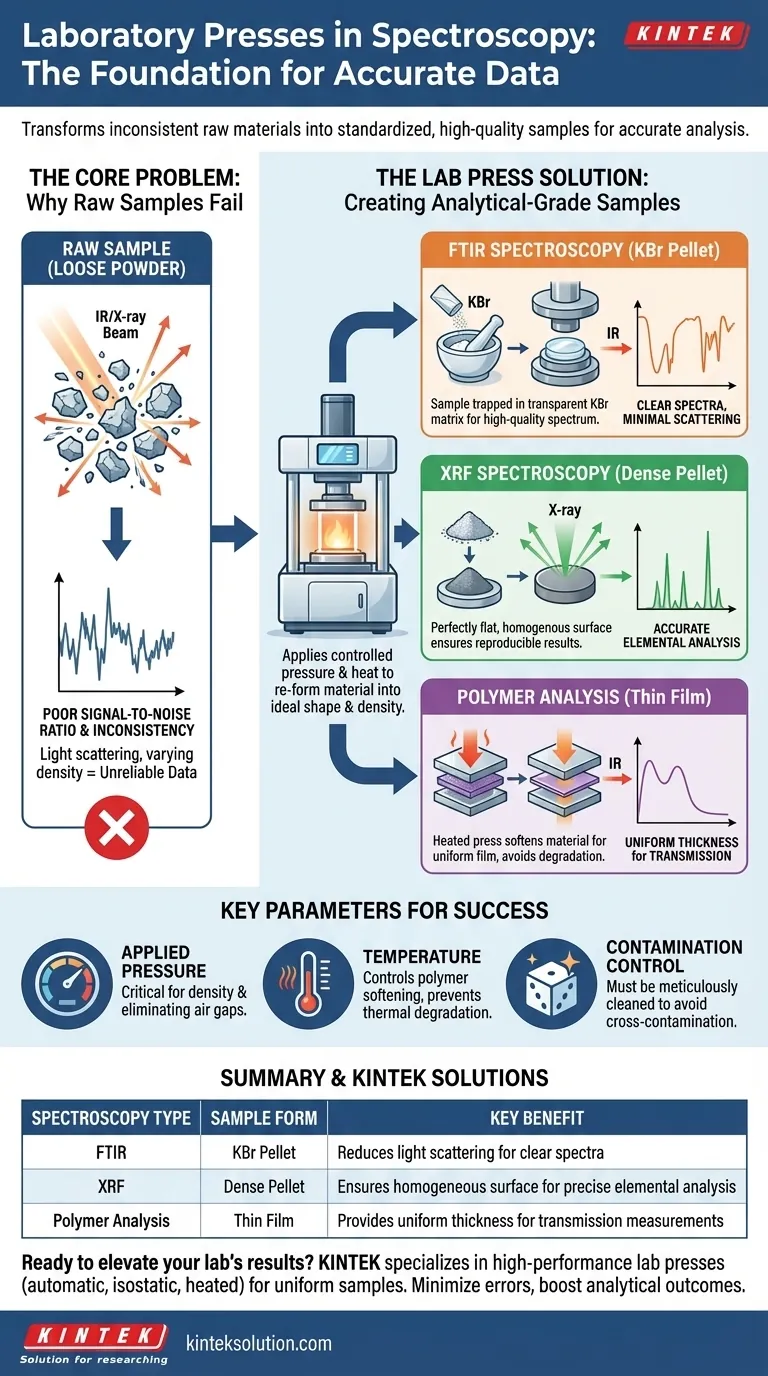
Related Products
- Automatic Laboratory Hydraulic Press Lab Pellet Press Machine
- Laboratory Hydraulic Press 2T Lab Pellet Press for KBR FTIR
- Lab Cylindrical Press Mold for Laboratory Use
- Square Lab Press Mold for Laboratory Use
- Laboratory Hydraulic Press Lab Pellet Press Machine for Glove Box
People Also Ask
- How does a hydraulic press aid in XRF spectroscopy? Achieve Accurate Elemental Analysis with Reliable Sample Prep
- What are the key steps for making good KBr pellets? Master Precision for Flawless FTIR Analysis
- What is the purpose of creating pellets for XRF spectroscopy using a hydraulic press? Ensure Accurate and Repeatable Elemental Analysis
- What are the advantages of using a hydraulic press for pellet production? Achieve Consistent, High-Quality Samples
- How are hydraulic presses used in the preparation of powder mixtures? Achieve Precise Compaction for Accurate Analysis


